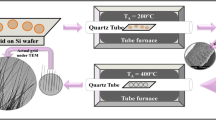Abstract
Carbon nanotubes (CNTs), with exceptional thermal and mechanical properties as well as inherently high surface area, are an attractive candidate for integrating into thermal structures of advanced power electronics. Growth of vertically aligned carbon nanotubes (VACNTs) directly onto copper (Cu) substrates is a promising approach to apply CNTs as novel thermal interface materials (TIMs) in electronics packaging. However, compared to growing CNTs on conventional inert substrates such as SiO2, direct growth of controllable CNT arrays onto Cu substrates is significantly more challenging due to the diffusion of metallic catalyst into the substrate during growth. By depositing an appropriate buffer layer on the Cu substrate surface, VACNTs of good alignment and high quality were reproducibly synthesized on the Cu substrate via the chemical vapor deposition (CVD) method in this study. The effect of different buffer layers on the CNT growth, nanotube structure and quality was investigated (SEM, Raman), particularly in terms of the interfacial properties between the CNT array and Cu substrate (Tensile compression force tester, Laser Flash Analysis). Our experimental results indicated that the buffer layer material, deposition method, and thickness play a key role in regulating the CNT layer growth/structure, leading to variable mechanical and thermal properties. The fundamental understanding thus obtained allows the successful synthesis of VACNT on copper substrates with desired structure and properties.
Similar content being viewed by others
References
Teresa de los Arcos, M.G. Garnier, Carbon (42), 187–190, 2004.
A. J. Hart, A. H. Slocum, Laure Royer, Carbon (44), 348–359, 2006.
S. Handuja, P. Srivastava, and V.D. Vankar, Nanoscale Res Lett (5), 1211–1216, 2010.
A. Cao, P.M. Ajayan, G. Ramanath, Applied Physics Letters (84), 109–111, 2004.
J. M. Simmons, B. M. Nichols, M. S. Marcus, O. M. Castellini, R. J. Hamers, and M. A. Eriksson, Small, vol. 2, no. 7, 902–909, 2006.
S. P. Patolea, J. H. Jeonga, S. M. Yub, H. J. Kimc, J. H. Hand, I.T. Hanc, J. B.Yoo, Applied Surface Science (271), 32– 38, 2013.
W.H. Wang, Y.R. Peng, C.T. Kuo, Diamond & Related Materials (14) , 1906 – 1910, 2005.
K. Sato, T. Shiraiwa, T. Maruyama, S. Naritsuka, J Nanosci Nanotechnol (6), 3929–33, 2010.
T. Ohashi, R. Kato, T. Tokune, H. Kawarada, Carbon., vol. 57, 401–409, 2013.
P. B. Amama, C. L. Pint, S. M. Kim, L. McJilton, K. G. Eyink, E. A. Stach, R, H. Hauge and B. Maruyama, ACS Nano (4), 895–904, 2010.
H. Liu, Y. Zhang, D. Arato, R. Li, P. Merel, Surface & coating Technology (202), 4114–4120, 2008.
Q. Zhang, B. Quinton, B. Tsao, J. Scofield, J. Merrett, J. Lawson1, K. Yost, L. Elston, 2014 MRS Fall Meeting proceedings, 2014.
Author information
Authors and Affiliations
Rights and permissions
About this article
Cite this article
Zhang, Q., Elston, L., Scofield, J. et al. The Effect of Buffer Layer on CNT Structure and CNT/Copper Interfacial Properties. MRS Advances 1, 1447–1452 (2016). https://doi.org/10.1557/adv.2016.201
Published:
Issue Date:
DOI: https://doi.org/10.1557/adv.2016.201




